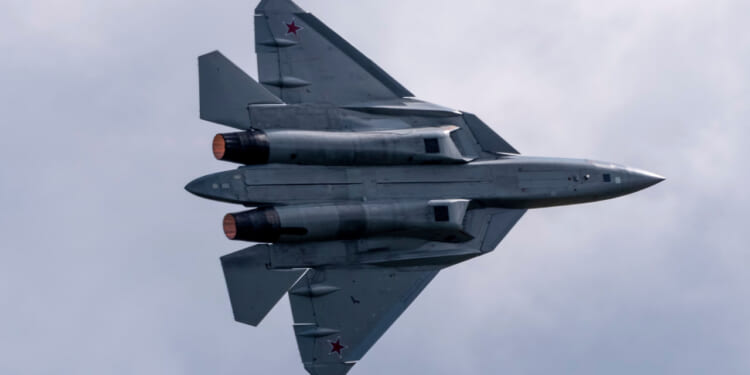The Su-57’s ability to carry so much ordnance elevates the platform’s lethality.
Russian officials have long touted that Sukhoi Su-57 fighter platform as an unparalleled fifth-generation masterpiece. While the aircraft certainly features some advanced elements, including stealth, supercruise, and supermaneuverability, aviation buffs still largely consider the Russian platform to lag behind its US counterparts. Last month, the new images depicting the Su-57’s hidden weapons bay emerged. An image depicting the fighter’s aft weapons bay door opened circulated widely on social media. According to defense outlets, the image appears to show two separate weapons stations that can likely hold both air-to-air and air-to-ground weapons. An additional weapons bay appears to lie ahead of the aircraft’s air intakes, as well as two side bays near the wing’s root. The published images mark the first time the jet’s weapons bays have been shown open, indicating the Kremlin wanted to show off the platform’s firepower.
As detailed by The Aviationist, “The design shows that there is a weapon station covered by each of the doors, although it is unclear if the Su-57 can open a single door to release a weapon or it has to open both. This translates into a ventral store payload capacity of four missiles, and a total of six considering the two side bays.” While detailing the exact number of missiles that can be launched from each bay is impossible based on the published image, the jet can certainly pack a punch. The Su-57’s ability to carry so much ordnance elevates the platform’s lethality. Notably, since these weapons are stored internally, drag is reduced and the fighter is able to fly with a lower radar profile, and thus with lower detection rates.
What Else Do We Know About the Su-57?
Designated by NATO as the Felon, the Russian fifth-generation platform was initially designed as a replacement aircraft for the Su-27 and MiG-29 fighters. When the Sukhoi Design Bureau first introduced the new aircraft, it represented a massive technological leap for Russia. While the jet features stealth, hefty weapon loads, and other key capabilities, perhaps the platform’s greatest hindrance is its power source. The Felon was originally constructed to be powered by the Izdeliye 30 engine, but many of the current models feature an older version. According to a RAND Corporation report, a majority of the Felon’s operational models will never fly with the intended engine. The same report also notes that, “Aside from the advanced engine, the Su-57 is touted as having an all azimuth, a.k.a. 360-degree sensing capacity similar to the F-35. After all, what makes a fifth-generation fighter bomber is not just its low observable (LO) features but also the advanced all azimuth sensor suite. At the present time, only the F-35 has both of these features and is in mass production.”
Representing Moscow’s sole fifth-generation fighter jet, the Felon should be playing a much greater role in the nation’s ongoing Ukraine invasion. The Su-57’s absence from the war suggests other issues or shortcomings surrounding the platform may be holding it back.
About the Author: Maya Carlin
Maya Carlin, National Security Writer with The National Interest, is an analyst with the Center for Security Policy and a former Anna Sobol Levy Fellow at IDC Herzliya in Israel. She has by-lines in many publications, including The National Interest, Jerusalem Post, and Times of Israel. You can follow her on Twitter: @MayaCarlin. Carlin has over 1,000 articles published over the last several years on various defense issues.
Image: aarrows / Shutterstock.com
















